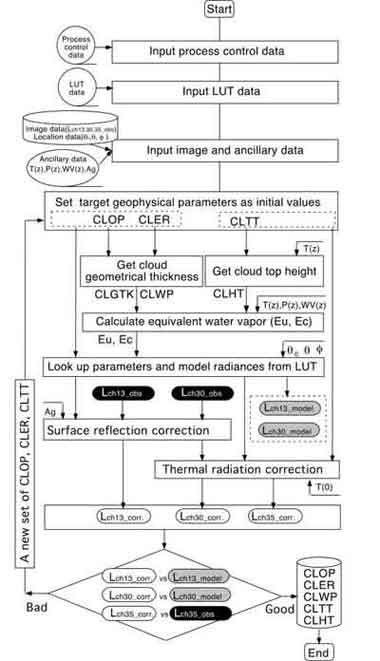Algorithm construction
“Algorithm” means theory and procedure for solving problems.
In satellite data analysis of Earth Observation, “solving problem” means to get certain physical parameters (air temperature, wind speed, cloud droplet size) from sensor signals (for example radiance and temperature observed by satellite sensors). And what is more, “theory and procedure” means laws and processing steps connecting sensor signals to physical parameters on the Earth. We call to program algorithms into computers systematically “data analysis system.”
After building algorithms we need study of data analysis system and algorithm validation.

To build algorithms, there are 3 ways: empirical method, semi empirical method, and physical method. Although all these ways have both merits and demerits, nowadays with developments of computers, the physical method is a mainstream.
Physical method
Physical method is to build a relation between sensor signals and physical parameters by using equation certified by science. For example, in the case that you want to guess cloud droplet size, sensor signals(L) is shown by an equation(f) dependent on the cloud droplet radius(R).
L=f(R)
To obtains this equation(f) needs “scattering problem of electro-magnetic waves.” Generally speaking, the equation(f) is very complicated. And so when we build algorithms practically, we often build database of simulating L by using program solving scattering of electro-magnetic waves (=radiative transfer code) and then use the database instead of the equation(f). In the process of getting R from L we need some more efforts. In general, one would solve equations by using a combination of newton method and iterative calculation method. Recently, artificial intelligence (neural network) method is also tried. In our laboratory we study how to build high-precision and high-speed algorithms. And we engage in validations to compare data getting on ground observations with results from satellite analysis.
As mentioned above, quality of the algorithms developed by physical method highly depend on effectiveness of radiative transfer program. Therefore “study of radiation transfer” is very important.

Reference) Algorithm flow chart for getting cloud optical thickness(τ), cloud droplet radius(R), cloud top temperature(Tc) from GLI sensors(extracted from ATBD for ADEOS-II/GLI by JAXA)
